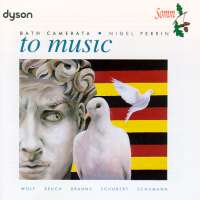|
German romanticsm is not necessarily thought of as a powerful force in
the part-song repertory. I've just proved to myself that it is, and the
accompanying ardour can be equally pervasive.
He of the popular violin concerto, Max Bruch, has a set of seven part-songs
all of which create an effect, are highly expressive, and in the case of
An die Musik deeply felt [listen -
track 10, 00:00-01:00]. A Hugo Wolf group is similarly - as one would
presumably expect of a lieder composer - blessed with a clutch of sensitive
images [listen - track 3, 00:00-00:45]. There
are also contributions from Schubert [listen - track
18, 00:00-00:56], Schumann, Brahms and early Schoenberg as a late romantic.
 As a mixed programme, the partsongs have some odd bedfellows
whose musical quality tends to outshine. For instance, Brahms' motet Warum
ist das Licht gegeben is austerely impressive; Schubert's Christ
ist erstanden moves with solemnity; and Schumann's Sommerlied has
a delicate air. One might add with wry amusement that Schoenberg's Ei,
du Lutte from his early twenties is skittish and plainly diatonic! As a mixed programme, the partsongs have some odd bedfellows
whose musical quality tends to outshine. For instance, Brahms' motet Warum
ist das Licht gegeben is austerely impressive; Schubert's Christ
ist erstanden moves with solemnity; and Schumann's Sommerlied has
a delicate air. One might add with wry amusement that Schoenberg's Ei,
du Lutte from his early twenties is skittish and plainly diatonic!
You might ponder the programmatic boundaries and a possible theme for
a mixed bag of short choral pieces. I don't detect one, other than selection
of a varied group of established composers whose approach to mixed-voice
miniatures threw up the occasional gem. Undoubtedly there are a few sparklers
here.
Copyright © Basil Ramsey, December
29th 1999
 PURCHASE THIS CD FROM CROTCHET
<< Music &
Vision homepage Comparing the two Haydns >>
PURCHASE THIS CD FROM CROTCHET
<< Music &
Vision homepage Comparing the two Haydns >>
 |
To listen to the aural illustrations in this review,
you may need to download RealNetworks' realplayer G2. |
Record Box is Music & Vision's regular Wednesday series
of shorter CD reviews
|